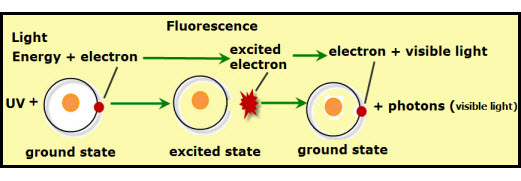Fluorescence and Photoluminescence are types of luminescence (cold light) where the energy is supplied by EMR (electromagnetic radiation). EMR from most to least energetic are: gamma rays, x-rays, ultraviolet light, visible light, infrared light, microwaves, and radio waves.
The starting EMR energy source needed to produce visible light must be more energetic than visible light. Thus, gamma rays, x-ray, and ultraviolet light can produce visible light.
Visible light is made up of different light colors. These colors in order of least to the greatest energy are: red, orange, yellow, green, blue, indigo, and violet.
Fluorescence is commonly used when the energy source is ultraviolet light.
Fluorescence is seen in fluorescent lights, the redness of rubies in sunlight, fluorescent markers, “day-glo” or “neon” colors. The whitening power of bleach is usually enhanced with white fluorescent material that covers the surface being bleached.
Photoluminescence is commonly used when the energy source is an EMR other than ultraviolet light.
The word, photoluminescence can be broken into two parts:
photo meaning light
luminescence meaning to give off light
Uniting these two parts builds the word photoluminescence, which means light production using light or EMR as the stating energy source.
For both fluorescence and photoluminescence, the source light being absorbed has a higher energy than the visible light emitted.
(Paid Link)

